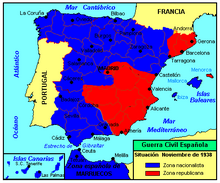Catalonia offensive
Spanish Civil War (1936-1939)
Gijón - Oviedo - Alcázar of Toledo - Mérida - Badajoz - Guipúzcoa - Mallorca - Sierra Guadalupe - Talavera de la Reina - Madrid - Road to Coruña - Málaga - Jarama - Guadalajara - War in the north ( Durango , Guernica , Santander ) - Brunete - Belchite - Teruel - Cabo de Palos - Aragon - Ebro - Catalonia
The Catalonia Offensive of Franco's insurgents marked the beginning of the last phase of the Spanish Civil War and ended with the defeat of the Republican forces .
course
After the last offensive in the Battle of the Ebro , which was costly for the Republicans, Franco's troops began the offensive against Catalonia on December 23, 1938. This was made easier by the fact that, after the losses on the Ebro, the Republicans hardly had any modern weapons to fend off their opponents. The units led by the anarchists initially held out, while the communist troops fell back in January. Arms deliveries from the Soviet Union for the Republicans no longer arrived, although France had temporarily opened its borders for transport. The Republican General Jose Miaja, who commanded the section near Madrid, refused to launch a relief attack. The result was a disorderly retreat of the republican troops from the superior enemy in Catalonia. Only a few, predominantly communist, units offered tentative resistance. Tarragona fell on January 14th. The insurgents were able to occupy Barcelona on January 26, 1939 without fighting . After the capture of Barcelona by Franco's troops, Prime Minister Negrín fled to France via Girona , as did many of the republic-loyal residents of Catalonia. On February 4, 1939, Franco's troops occupied the city of Girona. By February 10, all of Catalonia was occupied.
The only way for the Spanish Republican People's Army (Ejército Popular de la República, EPR) to escape from the approaching Franco troops was to retreat to the French border. More than half a million refugees fled from the approaching Franco troops from Catalonia. It was not until February 5th, due to international pressure, that the French government allowed the fugitives to enter France. Hundreds of thousands of civilians and the remains of the Republican People's Army then poured into France. By February 15, 1939, according to official information, 353,107 people had fled to the French department Pyrénées-Orientales , which at that time was home to around 230,000 people. According to a report by the French government (Informe Valière) of March 9, 1939, the number of refugees reached 440,000. Among the fugitives were 170,000 women, children and the elderly, 220,000 soldiers and militiamen, 40,000 invalids and 10,000 injured. Various internment camps were set up for the refugees, such as the Argelès-sur-Mer internment camp on the Mediterranean Sea.
On February 27, the governments of Great Britain and France officially recognized the Franco government.
As a result, the republican government was overthrown by the army in the area that remained to it, and further resistance was deemed futile. An attempt by a newly formed junta followed to come to an understanding with Franco so that his troops could occupy Madrid at the end of March 1939. That ended the civil war.
Web links
- Manfred Behrend: "Our cause was bad in Spain ..." 60 years after the barricade fight in Barcelona . Retrieved December 4, 2015.
- Florian Seelig: The 2nd (Spanish) Republic and the Spanish Civil War at a glance . In: aventinus. ISSN 2194-1963 . Retrieved December 4, 2015.
